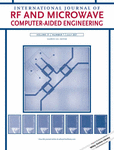Capacitive coupled circular patch antenna based rectenna systems for 5.8 GHz wireless power transfer applications
Abstract
This paper, a two- and four-element linear array of capacitively coupled microstrip patch antenna have been presented for 5.8 GHz wireless power transfer application. Initially, a 5.8 GHz matched rectifier has been designed that produces maximum 1.54 V output voltage across a 1.8 kΩ load for 4 dBm input power. The maximum calculated efficiency is found to be 52.70%. The rectifier was then connected with a spurious free antenna to form a rectenna, which provided 0.39 V output voltage across the load and maximum 34.34% efficiency for received power of 0.246 mw. Since efficiency was found low, next, an attempt has been made to increase the efficiency by increasing antenna gain. To do this, a two-element and a four-element linear array of the antenna have been formed and connected with the rectifier to form the rectennas. To suppress spurious responses of arrays C-shaped slot etched on ground and U-shaped stub is placed at microstrip feed line. The two- and four-element array showed 11.4 dB and 15 dB gain, respectively, at 5.8 GHz (compared to 4.17 dB of the single element antenna). Maximum output voltages and efficiencies of the rectenna formed using two and four-element arrays are 0.83 V, 0.915 V and 45.06%, 52.55% respectively.
Open Research
DATA AVAILABILITY STATEMENT
Data sharing not applicable to this article as no datasets were generated or analysed during the current study




